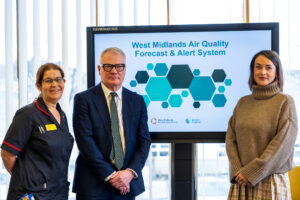On 6th November we held our fifth National Air Quality Conference – and our tenth conference overall – at Prospero House in London. It was our first visit to this venue and it didn’t disappoint.
Food is an important element of such events and Prospero House exceeded expectations in this department – I can confirm that an apple, fennel and ginger shot is a surprisingly energising way to start the day.
Cllr Beverley Nielsen again hosted the event and again held everything together throughout the day. The first speaker she was called on to introduce was Simon Birkett of Clean Air in London
Simon gave us an insight into his 20 years fighting for clean air – and he is certainly a tenacious campaigner. Simon has been behind many of the advancements in the clean air field, albeit that much of his work is out of the spotlight. He refers to a breakthrough meeting with DEFRA, after which he began a journey to calculate the real number of deaths caused by air pollution. His work in this area has done much to energise policy makers since, although possibly not as much as Simon would like.
He began pushing for a Low Emission Zone in London in 2006, two years before it became a reality and has also involved himself in legal action to further the cause, financing ClientEarth’s battle with DEFRA, which ultimately forced the government to produce a ‘meaningful air quality plan.’ He also helped draft the Clean Air (Human Rights) Bill, aka Ella’s Law.
It was fascinating and instructive to hear how Simon became particularly active prior to the London Olympics, recongising the event as ‘a campaigner’s dream’. Just months before the games began, Clean Air in London lodged a formal complaint with the European Commission over the UK’s failure to comply with air quality laws.
Entertainingly, Simon told us how he busied himself around the Olympic site at night to find evidence of air pollution suppressing trucks, a tactic that he has described elsewhere as ‘public health fraud’.
Next to speak was Diana Varaden from Imperial College London. Diana discussed the four-year WellHome study, which is just entering its final year.
The study focuses on air quality inside and outside 100 homes of children with asthma in White City, West London and, while the results of the programme will emerge in the coming year, Diana explained the nature of the research and, significantly, how they had found the best ways to engage with the community.
The problem with indoor air pollution is how to study it and, inevitably, this Imperial project is relatively intrusive, with monitors being placed in the kitchen, bedroom and living room of participating homes for two 28 day periods (one in Summer, the other in Winter). Diana explained exposure to indoor air pollution is complex and personal, dependent on factors such as cooking, heating and cleaning practices.
The get the community on board the team held a big science festival at the start of the project and recruited some local ambassadors to help them engage with home owners (one of whom attended the event). The team approached the project with flexible ideas of how they wanted to approach it and these ideas were adapted according to feedback they received.
As the data is analysed, the results will be shared with the participants, allowing them to see how they might change their behaviour to improve their quality of life.
After a coffee break in which the delegates could chat with our exhibitors and examine their wares, we reconvened with our traditional discussion panel.
For this Beverley was joined by Tim Dexter, the Clean air lead at Asthma + Lung UK, Dr. Meredith Robertson, a consultant in respiratory medicine, and Hackney Council’s Dave Trew who helped develop the Air Aware tool.
The discussion covered a variety of topics, prompted by questions from the delegates in the room. While there was one question (is there any danger in smoked food) that the panel didn’t entirely get their teeth into, there were plenty of others that energised them. Meredith would like to see patients’ medical records coded if they live in areas of high pollution, so if they suffer a fatal asthma attack or stroke, the coroner can take this into account.
Indoor air quality was discussed, with Tim observing that there’s almost an excess of evidence on ambient air quality so research is inevitably heading in that direction. Dave told us that Hackney are including indoor air in their Air Quality Action Plan. All agreed that a concerted information campaign to educate the public would be hugely useful.
Another delegate asked whether we should start monitoring submicron particles and Dave replied that he thinks that will happen eventually: ‘after all, we didn’t use to monitor PM2.5’.
Another question, from a councillor who had seen just 120 responses to a clean air consultation, queried whether there was a general apathy towards air quality amongst the public. Meredith felt there was some truth in the idea and that it’s invisibility was a factor in this. She’s had plenty of people ask about air quality when they suffer from damp and mould but otherwise people tend not to be concerned.
After a very well-received, bento box-based lunch, Ella Patel talked abut the work Vortex have undertaken to help councils keep on top of local air quality. Specifically she discussed their work with the London Borough of Hammersmith & Fulham and Cardiff Council in establishing monitoring networks.
In Hammersmith the council now have a greater understanding of pollution source apportionment through VTX Air monitors which run on the VTX Mesh network, allowing the council to combine street-level air quality data with other data such as traffic technologies. This enables them to manage traffic in real-time and develop dynamic policies to tackle air pollution.
Sarah Legge has many hats but here she was wearing her EPIC one, as the Chair of their Task Group on Air Quality and Climate Change Guidance.
Last month EPIC published a guidance document titled: ‘Integrating Action on Air Quality & Climate Change: A Guide for Local Authorities’ and the conference provided the perfect place for her to explain it in detail. She introduced EPIC as a charity made up of environmental specialists tryin to ensure policy is implemented effectively.
The new guidance represents a major update of some published by EPUK in 2013 and it starts from the premise that air pollution and climate change are two sides of the same coin. One affects the other.
The guidance offers 23 measures that local authorities can take in the areas of transport and the built environment (plus waste and sustainable procurement) and indicates the positive and negative affects they might have.
The measures are designed so they can be implemented at different scales, depending on the level of ambition or geographical scope.
This year’s conference had arguably our highest ever proportion of local authority delegates, so inevitably Sarah faced a lot of questions at the end.
Our final two speakers, who addressed the room following our afternoon break, were also of particular interest to the local authority members in the audience.
The first of these was Christopher Hammond, the Chief Executive of UK100, a cross-party membership organisation that represents 150 councils, supporting them on their Net Zero and Clean Air targets.
As a former leader of Southampton City Council, Christopher has direct experience of working in local authorities and recognised that they are not currently in a ‘good place.’ He described the UK as excessively centralised, with too much power in Whitehall, despite the fact that local investment delivers a more just transition.
He quoted PWC figures that place-based investment delivers a much greater return (£14 for every £1 spent) than agnostic-based. Furthermore, he argued, local investment works on a social level as well as an economic one.
Christopher accepts that the autumn budget brought some good news for local authorities but points out that the cost and complexity of bidding for government money often prevents councils from even trying.
Christopher also shared what some councils were doing, emphasising that while there was no statutory duty on LAs to deliver net zero, local political leadership means nearly all of them have policies in place.
Finally came Fiona Coull who manages Cross River Partnership’s Smarter Greener Logistics. She explained the various trials that CRP have undertaken to investigate ways of moving freight around London with the minimum emissions.
In 2020, 450 million parcels were delivered in London and 80% of them were delivered by road. By 2030 this figure is expected to have doubled so there is an obvious need for the work CRP are doing. The trials so far undertaken have provided a wealth of fascinating data, such as the fact that when used for last mile deliveries, one cargo bike can save 5 tonnes of CO2 in a year.
One of CRP’s flagship schemes has been the micro logistics hubs which we have covered before in these pages, but Fiona also told us about the Light Freight Walking Trial, in which deliveries were made on foot within a 2km radius of Heals in Fitzrovia. An electric vehicle replenished the delivery people halfway through their route.
Then there are the river freight trials, bringing goods into the centre of London along the Thames, and a rail freight at Waterloo Station. Again, the session generated a lot of questions, one being whether the Thames trial could be replicated on other rivers. Yes, said Fiona, ‘in fact we are talking to New York about it at the moment’.
And on that note the day came to a close. It’s an inevitability at events such as these that, for a variety of reasons, people slip away before the end. However, there were more people still in Prospero House at the end of the day than I’ve seen before. A genuine testament to the quality of our speakers, so I’d to thank them all for giving their time to make the event such as successful one.
In the fullness of time, we will upload the various presentations to this website, so you can dig further into the debate.
















Leave a Reply